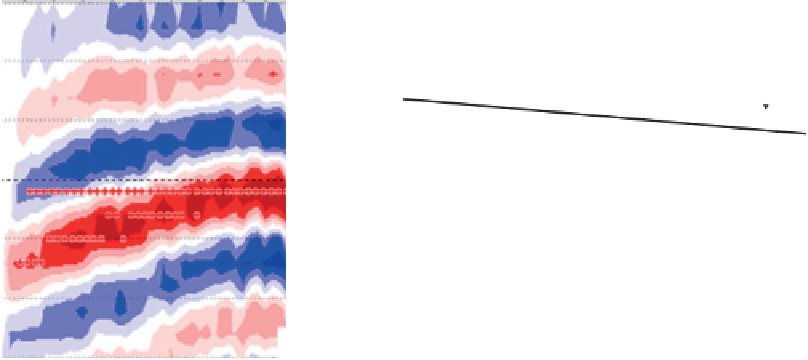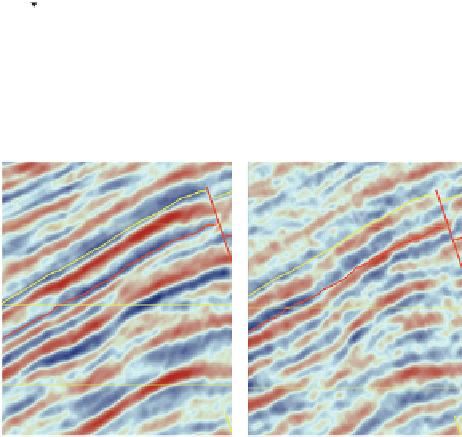Geology Reference
In-Depth Information
offset
reflection
0.5
0.1
0.05
sample
-0.0
-0.05
-0.1
0
0.1
0.2
0.3
0.4
0.5
sin
2
θ
Figure 6.10
The effect of residual moveout on the AVO intercept and gradient. The gradient is far more sensitive to the effect than the
intercept (after Bacon
et al.
,
2003
)
a)
Near
b)
Far
errors can be exploited as a way to obtain more
accurate velocities in an automated procedure (Swan,
2001
). If the AVO study proceeds from raw gathers
with processing software available then applying such
a process is relatively straightforward. However, in
many cases there is not enough time available before
completion of an AVO study for re-interpretation of
velocities to be a realistic option.
A possible approach would be to improve the
alignment by applying a trim static time-shift, calcu-
lated as the shift required to give the best alignment
between the trace and a reference trace (e.g. the full
stack trace). This requires some care in the size of the
gate used for correlation and the maximum time-shift
permitted; it works best when there are some high-
amplitude events of distinctive character, to avoid
miscorrelations due to noise. Class IIp AVO effects
are a particular problem because of the polarity flip
between near and far traces, creating the possibility of
incorrectly correlating a peak (for example) on the
near trace with a peak on the far trace, whereas the
correct correlation should be to a trough. Compari-
son with an offset synthetic may be needed to deter-
mine whether residual moveout is present. Also,
wavelet phase changes across the offset range should
be removed prior to applying trim statics, preferably
by making all the data zero phase.
Figures 6.12
and
6.13
show a North Sea example
where gather flattening has led to an improvement in
the AVO gradient estimation (Gulunay et al.,
2007
).
Figure 6.11
Partial stacks showing residual moveout. The red
picked horizon shows an apparent phase reversal from near to far in
the updip part of the structure.
from near to far in the right-hand part of the section,
but this is in fact simply an effect of residual moveout.
This would be much easier to recognise in the gathers
but interpreters often do not have quick access to
gathers during interpretation. A way of handling
residual moveout on stacked data is to make separate
horizon picks on the near and far stacks, then meas-
ure the amplitudes and perform AVO analysis (such
as described in
Chapter 5
) on the horizon amplitude
maps rather than in a volume.
If the cause of the misalignment is an inaccurate
velocity model, the proper solution is to correct the
velocities. Indeed, the sensitivity of AVO to velocity
120










































































